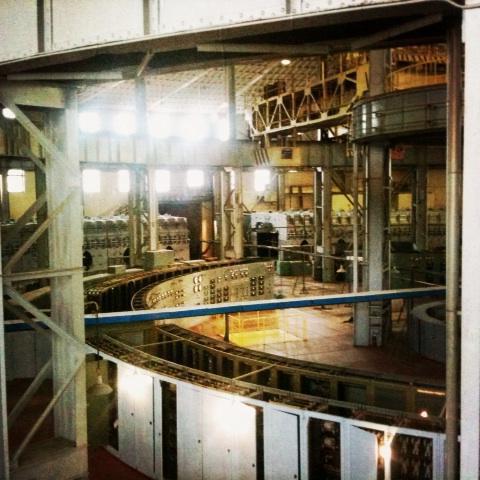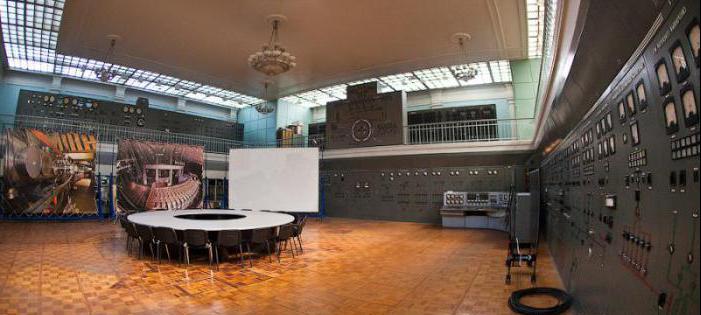Technology in the USSR developed rapidly. What is the launch of the first artificial Earth satellite, which was watched by the whole world. Few people know that in the same 1957, the synchrophasotron started working (that is, it was not just completed and put into operation, namely, launched). This word means an installation for dispersing elementary particles. Almost everyone today heard about the Large Hadron Collider - it is a newer and improved version of the device described in this article.
What is a synchrophasotron? What is it for?
This installation is a large accelerator of elementary particles (protons), which allows you to more deeply study the microworld, as well as the interaction of these particles with each other. The way of studying is very simple: break protons into small parts and see what is inside. Everything sounds simple, but breaking a proton is an extremely difficult task, the solution of which required the construction of such a huge structure. Here, through a special tunnel, particles are accelerated to huge speeds and then sent to the target. Hitting it, they scatter into small fragments. The closest "colleague" of the synchrophasotron, the Large Hadron Collider, operates on approximately the same principle, only there the particles accelerate in opposite directions and hit not against a standing target, but collide with each other.
Now you understand a little that it is a synchrophasotron. It was believed that the installation will make a scientific breakthrough in the field of microworld research. In turn, this will open up new elements and ways to get cheap energy sources. Ideally, they wanted to discover elements that were superior in efficiency to enriched uranium and which were less harmful and easier to dispose of.
Military use
It is worth noting that this installation was created for the implementation of a scientific and technological breakthrough, but its goals were not only peaceful. In many ways, the scientific and technological breakthrough is obliged to the arms race. The synchrophasotron was created under the heading "Top Secret", and its development and construction was carried out as part of the creation of the atomic bomb. It was assumed that the device would create a perfect theory of nuclear forces, but it was not so simple. Even today, this theory is absent, although technological progress has stepped far forward.
What is a synchrophasotron in simple words?
If to generalize and speak in a clear language? A synchrophasotron is an installation where protons can be accelerated to high speed. It consists of a looped tube with a vacuum inside and powerful electromagnets that prevent protons from moving randomly. When protons reach their maximum speed, their flow is directed to a special target. Hitting it, protons scatter into small fragments. Scientists can see the traces of flying fragments in a special bubble chamber, and from these traces they analyze the nature of the particles themselves.
The bubble chamber is a slightly outdated device for fixing traces of protons. Today, more accurate radars are used in such installations, giving more information about the movement of proton fragments.
Despite the simple principle of the synchrophasotron, this installation itself is high-tech, and its creation is possible only with a sufficient level of technical and scientific development, which, of course, the USSR possessed. If we give an analogy, then a conventional microscope is the device whose purpose coincides with the appointment of the synchrophasotron. Both devices allow you to explore the microworld, only the latter allows you to "dig deeper" and has a somewhat peculiar research method.
In detail
Above, the operation of the device was described in simple words. Of course, the principle of action of the synchrophasotron is more complex. The fact is that in order to accelerate particles to high speeds, it is necessary to provide a potential difference of hundreds of billions of volts. This is impossible even at the current stage of technology development, not to mention the previous one.
Therefore, it was decided to disperse the particles gradually and drive them in a circle for a long time. On each circle, the protons were energized. As a result of passing millions of revolutions, we managed to gain the required speed, after which they were sent to the target.
This is the principle that was used in the synchrophasotron. At first, the particles moved through the tunnel at a slow speed. On each circle, they fell into the so-called acceleration intervals, where they received an additional charge of energy and gained speed. These acceleration sections are capacitors whose frequency of alternating voltage is equal to the frequency of protons passing through the ring. That is, the particles hit the acceleration site with a negative charge, at this moment the voltage increased sharply, which gave them speed. If the particles hit the acceleration site with a positive charge, then their motion was slowed down. And this is a positive feature, because because of it, the entire proton beam moved at the same speed.

And so it was repeated millions of times, and when the particles acquired the required speed, they were sent to a special target, about which they were broken. After a group of scientists studied the results of particle collisions. This is how the synchrophasotron worked.
The role of magnets
It is known that powerful electromagnets were also used in this huge particle acceleration machine. People mistakenly believe that they were used to disperse protons, but this is not so. Particles were accelerated using special capacitors (acceleration sections), and magnets only kept protons in a strictly specified trajectory. Without them, the consistent motion of a beam of elementary particles would be impossible. And the high power of electromagnets is explained by the large mass of protons at a high speed of movement.
What problems did scientists face?
One of the main problems in creating this setup was precisely in the dispersal of particles. Of course, they could be given acceleration on each circle, but with acceleration their mass became higher. At a speed close to the speed of light (as you know, nothing can move faster than the speed of light), their mass became huge, which made it difficult to keep them in a circular orbit. From the school curriculum, we know that the radius of motion of elements in a magnetic field is inversely proportional to their mass, so with increasing mass of protons we had to increase the radius and use large strong magnets. Such laws of physics severely limit research opportunities. By the way, they can also explain why the synchrophasotron turned out to be so huge. The larger the tunnel, the larger magnets can be installed to create a strong magnetic field to maintain the desired direction of proton motion.

The second problem is energy loss during movement. Particles passing through a circle emit energy (lose it). Therefore, when moving at speed, part of the energy evaporates, and the higher the speed of movement, the higher the loss. Sooner or later, the moment comes when the values of the radiated and received energy are compared, which makes it impossible to further disperse the particles. Therefore, there is a need for large capacities.
We can say that we now more accurately understand that this is a synchrophasotron. But what exactly did scientists achieve during the tests?
What research has been done?
Naturally, the operation of this installation did not pass without a trace. And although she was expected to get more serious results, some studies were extremely useful. In particular, scientists studied the properties of accelerated deuterons, heavy ion interactions with targets, and developed a more efficient technology for the disposal of spent uranium-238. And although for an ordinary person all these results say little about anything, in the scientific sphere their significance can hardly be overestimated.
Application Results
The results of tests conducted at the synchrophasotron are applied even today. In particular, they are used in the construction of nuclear power plants, used in the creation of space rockets, robotics and sophisticated equipment. Of course, the contribution to science and technological progress of this project is quite large. Some results are applied in the military sphere. And although scientists were unable to discover new elements that could be used to create new atomic bombs, no one really knows if this is true or not. It is possible that some results are hidden from the public, because it is worth considering that this project was implemented under the heading "Top Secret".
Conclusion
Now you understand that this is a synchrophasotron, and what is its role in the scientific and technological progress of the USSR. Even today, such facilities are actively used in many countries, but there are already more advanced options - the Nuclotrons. The Large Hadron Collider is perhaps the best implementation of the synchrophasotron idea to date. The use of this setup allows scientists to more accurately know the microworld due to the collision of two beams of protons moving at huge speeds.
As for the current state of the Soviet synchrophasotron, it was converted into an electron accelerator. Now works at the Lebedev Physical Institute.